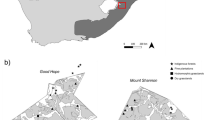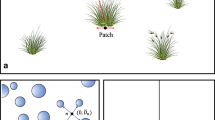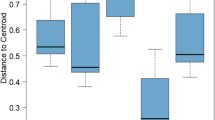Abstract
We evaluated the potential of soil microarthropods and enchytraeid worms to be useful as bioindicators of soil condition in forest, wetland, and agricultural ecosystems over a range of ecoregions. Selected mesofauna and soil characteristics in soil and litter in relatively undisturbed and disturbed examples of each of three ecosystems within each of three land resource regions were monitored over two years. Optimal times of year to sample these organisms as indicators of disturbance were April, May, July and September. No single measure reflected disturbance across all three ecosystems. Among forest sites, Simpson’s diversity index, evenness, abundance of ants, and proportion of enchytraeids in the mesofauna differed between soils of different disturbance levels. Among agricultural sites, richness, evenness, abundance of mites, and proportions of collembolans and of enchytraeids in the mesofauna differed between disturbance levels. Among wetland sites, Shannon’s and Simpson’s diversity indices, richness based on the total mesofauna, and abundances of mites, diplurans, ants, and isotomid and onychiurid collembolans differed between disturbance levels. Covariates most frequently associated with abundance and diversity of the measured mesofauna were soil electrical conductivity, available N, organic matter, and pH. Canonical correspondence analysis provided information somewhat different to bivariate analysis. Using both approaches to examine soil and litter taxa that have distinctive responses to disturbance may help to identify candidate groups applicable for use in large-scale environmental monitoring programs.
Similar content being viewed by others
References
Baur, B., Joshi, J., Schmid, B., Hanggi, A., Borcard, D., Stary, J., et al. (1996). Variation in species richness of plants and diverse groups of invertebrates in three calcareous grasslands of the Swiss Jura mountains. Revue Suisse de Zoologie, 103, 801–833.
Bird, S., Coulson, R. N., & Crossley Jr., D. A. (2000). Impacts of silvicultural practices on soil and litter arthropod diversity in a Texas pine plantation. Forest Ecology and Management, 131, 65–68.
Briones, M. J. I., Ineson, P., & Piearce, T. G. (1997). Effects of climate change on soil fauna: responses of enchytraeids, Diptera larvae and tardigrades in a transplant experiment. Applied Soil Ecology, 6, 117–134.
Chagnon, M., Paré, D., & Hébert, C. (2000). Relationships between soil chemistry, microbial biomass and the collembolan fauna of southern Québec sugar maple stands. Ecoscience, 7, 307–316.
Dash, M. C. (1990). Oligochaeta: Enchytraeidae. In D. L. Dindal (Ed.), Soil biology guide (pp. 311–340). New York: Wiley.
Didden, W. A. M., Frund, H.-C., & Graefe, U. (1997). Enchytraeids. In G. Benckiser (Ed.), Fauna in soil ecosystems: Recycling processes, nutrient fluxes, and agricultural production (pp. 135–172). New York: Marcel Dekker.
Donegan, K. K., Watrud, L. S., Seidler, R. J., Maggard, S. P., Shiroyama, T., Porteous, L. A., et al. (2001). Soil and litter organisms in Pacific Northwest forests under different management practices. Applied Soil Ecology, 18, 159–175.
Dyer, L. A., & Letourneau, D. (2003). Top-down and bottom-up diversity cascades in detrital vs. living food webs. Ecology Letters, 6, 60–68.
Fiscus, D. A., & Neher, D. A. (2002). Distinguishing nematode genera based on relative sensitivity to physical and chemical disturbances. Ecological Applications, 12, 565–575.
Fromm, H., Winter, K., Filser, J., Hantschel, R., & Beese, F. (1993). The influence of soil type and cultivation system on the spatial distributions of the soil fauna and microorganisms and their interactions. Geoderma, 60, 109–188.
Hawksworth, D. L., & Ritchie, J. M. (1993). Biodiverity and Biosystematic Priorities: Microorganisms and Invertebrates. Wallingford: CAB International.
Herrick, J. E. (2000). Soil quality: an indicator of sustainable land management. Applied Soil Ecology, 15, 75–83.
Hill, M. O. (1973). Diversity and evenness: A unifying notation and its consequences. Ecology, 54, 427–432.
Hulugalle, N. R., de Bruyn, L. A. L., & Entwistle, P. (1997). Residual effects of tillage and crop rotation on soil properties, soil invertebrate numbers and nutrient uptake in an irrigated Vertisol sown to cotton. Applied Soil Ecology, 7, 11–30.
Koehler, H. H. (1999). Predatory mites (Gamasina, Mesostigmata). Agriculture, Ecosystems & Environment, 74, 395–410.
Lagerlöf, J., & Andrén, O. (1988). Abundance and activity of soil mites (Acari) in four cropping systems. Pedobiologia, 32, 129–145.
Liiri, M., Setala, H., Haimi, J., Pennanen, T., & Fritze, H (2002). Relationship between soil microarthropod species diversity and plant growth does not change when the system is disturbed. Oikos, 96, 137–149.
Lindberg, N., Engtsson, J. B., & Persson, T. (2002). Effects of experimental irrigation and drought on the composition and diversity of soil fauna in a coniferous stand. Journal of Applied Ecology, 39, 924–936.
Link, W. A., Barker, R. J., & Sauer, J. R. (1994). Within-site variability in surveys of wildlife populations. Ecology, 75, 1097–1108.
Loranger, G., Bandyopadhyaya, I., Razaka, B., & Ponge, J.-F. (2001). Does soil acidity explain altitudinal sequences in collembolan communities. Soil Biology & Biochemistry, 33, 381–393.
Lubchenco, J., Olson, A. M., Brubaker, L. B., Carpenter, S. R., Holland, M. M., Hubbell, S. P., et al. (1991). The sustainable biosphere initiative: An ecological research agenda. Ecology, 72, 371–412.
Ludwig, J. A., & Reynolds, J. F. (1988). Statistical ecology: A primer on methods and computing. New York: Wiley.
Miyazawa, K., Tsuji, H., Yamagata, M., Nakano, H., & Nakamoto, T. (2002). The effects of cropping systems and fallow managements on microarthropod populations. Plant Production Science, 5, 257–265.
Morisita, M. (1959). Measuring of interspecific association and similarity between communities. Memoirs of the Faculty of Science, Kyushu University Series E. Biology, 3, 65–80.
Neher, D. A., Barbercheck, M. E., El-Allaf, S. M., & Anas, O. (2003). Effects of disturbance and ecosystem on decomposition. Applied Soil Ecology, 23, 165–179.
Neher, D. A., & Campbell, C. L. (1994). Nematode communities and microbial biomass in soils with annual and perennial crops. Applied Soil Ecology, 1, 17–28.
Neher, D. A., Easterling, K. N., Fiscus, D., & Campbell, C. L. (1998). Comparison of nematode communities in agricultural soils of North Carolina and Nebraska. Ecological Applications, 8, 213–223.
Neher, D. A., Peck, S. L., Rawlings, J. O., & Campbell, C. L. (1995). Measures of nematode community structure and sources of variability among and within fields. Plant Soil, 170, 167–181.
Neher, D. A., Wu, J., Barbercheck, M. E., & Anas, O. (2005). Ecosystem type affects interpretation of soil nematode community measures. Applied Soil Ecology, 30, 47–74.
Nkem, J. N., de Bruyn, L. A. L., Grant, C. D., & Hulugalle, N. R. (2000). The impact of ant bioturbation and foraging activities on surrounding soil properties. Pedobiologia, 44, 609–621.
Nowak, E. (2001). Enchytraeid communities in successional habitats—(from meadow to forest). Pedobiologia, 45, 497–508.
Parisi, V., Menta, C., Gardi, C., Jacomini, C., & Mozzanica, E. (2005). Microarthropod communities as a tool to assess soil quality and biodiversity: a new approach in Italy. Agriculture, Ecosystems & Environment, 105, 323–333.
Peck, S. L., McQuaid, B., & Campbell, C. L. (1998). Using ant species (Hymenoptera: Formicidae) as a biological indicator of agroecosystem condition. Environmental Entomology, 27, 1102–1110.
Pietikainen, A. S., Haimi, J., & Siitonen, J. (2003). Short-term responses of soil macroarthropod community to clear felling and alternative forest regeneration methods. Forest Ecology and Management, 172, 339–353.
Rebek, E. J., Hogg, D. B., & Young, D. K. (2002). Effect of four cropping systems on the abundance and diversity of epedaphic springtails (Hexapoda: Parainsecta: Collembola) in southern Wisconsin. Environmental Entomology, 31, 37–46.
Ruf, A. A. (1998). Maturity Index for predatory soil mites (Mesostigmata:Gamasina) as an indicator of environmental impacts of pollution on forest soils. Applied Soil Ecology, 9, 447–452.
SAS Institute Inc. (2000). SAS Online Doc, Version 8. SAS Institute: Cary, North Carolina.
Schlaghamersky, J. (2002). The Enchytraeidae of spruce forest plots of different exposure and acid deposition in a German mountain range. European Journal of Soil Biology, 38, 305–309.
ter Braak, C. J. F., & Smilauer, P. (2002). CANOCO Reference Manual and CanoDraw for Windows User’s Guide, Software for Canonical Community Ordination (version 4.5). Wageningen and Ceske Budejovice: Biometris.
The H. John Heinz Center for Science, Economics and the Environment (2002). The state of the nation’s ecosystems: Measuring the lands, waters, and living resources of the United States. New York: Cambridge University Press.
Thompson, I. D. (2006). Monitoring of biodiversity indicators in boreal forests: a need for improved focus. Environmental Monitoring and Assessment, 121, 263–273.
Topoliantz, S., Ponge, J. F., & Viaux, P. (2000). Earthworm and enchytraeid activity under different arable farming systems, as exemplified by biogenic structures. Plant Soil, 225, 39–51.
Tshiguvho, T. E., Dean, W. R. J., & Robertson, H. G. (1999). Conservation value of road verges in the semi-arid Karoo, South Africa: ants (Hymenoptera: Formicidae) as bio-indicators. Biodiversity and Conservation, 8, 1683–1695.
Van Straalen, N. M., & Verhoef, H. A. (1997). The development of a bioindicator system for soil acidity based on arthropod pH preferences. Journal of Applied Ecology, 34, 217–232.
van Vliet, P. C. J., Beare, M. H., & Coleman, D. C. (1995). Population dynamics and functional roles of Enchytraeidae (Oligochaeta) in hardwood forest and agricultural ecosystems. Plant and Soil Science, 63, 237–235.
Vu, Q. M., & Nguyen, T. T. (2000). Microarthropod community structures (Oribatei and Collembola) in Tam Dao National Park, Vietnam. Journal of Biosciences, 25, 379–386.
Wall, D. H., 1999. Biodiversity and ecosystem functioning. BioScience, 107–08.
Wander, M. M., & Drinkwater, L. E. (2000). Fostering soil stewardship through soil quality assessment. Applied Soil Ecololgy, 15, 61–73.
Whitford, W. G., van Zee, J., Nash, M. S., Smith, W. E., & Herrick, J. E. (1999). Ants as indicators of exposure to environmental stressors in North American desert grasslands. Environmental Monitoring And Assessment, 54, 143–171.
Wolda, H. (1981). Similarity indices, sample size and diversity. Oecologia, 50, 296–302.
Author information
Authors and Affiliations
Corresponding author
Rights and permissions
About this article
Cite this article
Barbercheck, M.E., Neher, D.A., Anas, O. et al. Response of soil invertebrates to disturbance across three resource regions in North Carolina. Environ Monit Assess 152, 283–298 (2009). https://doi.org/10.1007/s10661-008-0315-5
Received:
Accepted:
Published:
Issue Date:
DOI: https://doi.org/10.1007/s10661-008-0315-5




